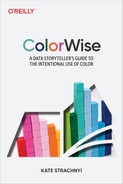Preface
It’s the day of the big interview for the job you’ve been after all your life. You wake up extra early, eat a healthy, energizing breakfast, take a 30-minute jog to get all your synapses firing, and take a hot shower to feel fully ready to conquer the world. You’ve got your clothes all laid out to impress the interview team with your sense of style and professionalism and head out the door in your bright red jacket, lime green pants, and neon purple shirt. Look out world, here you come (Figure P-1)!

Figure P-1. Mismatched outfit with a mix of colors
Cringeworthy, right? Unless the position you are interviewing for is a clown at the circus, those colors are not going to do the job today or any other day. We are extraordinarily cautious with the colors we choose to wear, the colors we paint our homes with, the colors we choose for our cars, even the colors we select for our oh-so-important smartphone cases!
Yet when it comes time to select colors for our infographics and data visualization creations, we often act like someone shook up a rainbow and spilled it all over the floor. Color is by far the most abused and neglected tool in data visualization. We abuse it by making color choices that make no sense, and we neglect it when we populate our hard work with software default settings, which are a good place to start but can be customized to suit your needs.
The lack of focus and commitment to color is a perplexing thing. When used correctly, color has no equal as a visualization tool—in advertising, in branding, in getting the message across to any audience you seek. Data analysts can make numbers dance and sing on command, but they sometimes struggle to create visually stimulating environments that convince the intended audience to tap their feet in time. Sales and marketing experts understand the customer’s mindset, but often cannot seem to help from turning simple charts and graphs into a kaleidoscope of shades and hues that require a roadmap to figure out which side is up.
Fortunately, in the preceding example, we don’t have to design our own fashions, although we do need to be responsible for being the best infographic tailors we can be to get color combinations that fit our purposes, engage our intended audiences, and draw the eye to the exact spot we want it to deliver the intended message every time.
Why I Wrote This Book
As founder of DATAcated, I see a staggering and frustrating amount of data visualizations where color is being poorly used on a weekly basis. Dozens of years ago when color was still a luxury on paper reports, and most businesses were still living in a black-and-white environment, misusing color wasn’t the death knell that it is today. But with every business worth its salt the world over now fully embracing the digital revolution, real-time collaboration, and all of the bells and whistles that go with these advances, knowing how to use color appropriately has evolved from a nicety to a necessity.
We learn about color from an early age, but understanding how it connects our eyes to our brains and how the proper usage can transform graphics is an elusive subject for many. That’s why I decided to undertake this book: to go on a mission to educate business and data professionals on the proper use of color.
The power of the internet and digital technology has clogged every industry and every niche with a glut of businesses all pursuing the same finite number of customers. That means companies need to scrape and claw for the type of differentiation that will elevate them away from the competition and crystalize why their offering is the best one on the market, whether that’s for end-use customers, in business-to-business (B2B) relationships, or to promote their own projects inside the company environment.
How This Book Is Organized
This is a book that can be read in two ways. You can take it from beginning to end, creating a base of knowledge that starts at the broadest of foundations and builds upon that knowledge to define and refine very specific concepts of color as they relate to data visualization. Or, if you have experience in the field already, you can use this book as a reference guide that can greatly augment your existing skills when it comes to utilizing color correctly to represent data in graphs, charts, tables, and infographics. In doing so, you can learn more about not only the individual tips and tricks but also the theory behind them, why they work the way they do, and how to take the basics and augment them for your own future projects.
Regardless of which route you decide to take—and feel free to try both—this book will educate you on:
The history, biology, and psychology of color theory
Definitions of data visualization and data storytelling and color’s vital role in both
A myriad of rules and suggestions on how to select the best color scheme for your next data visualization
How to appropriately address color vision deficiency to avoid alienating those without the full range of visual capabilities
A closer consideration of color in cultural design
Some common errors to avoid when using color in data visualization and storytelling
That list is just the tip of the iceberg. We’re going to take a journey across time, various industries, and some fantastic case uses of color that depict both spectacular success and avoidable failure.
If you take away a few things from this text, I hope they include the following:
Use color intentionally in everything you do. Don’t just use the default settings in your data analysis or business intelligence software because you think it “knows best.” As the data visualization designer, you possess the knowledge and power to use color intentionally to help tell your story.
Be aware of color vision deficiency. It affects more people than you think and involves a whole host of conditions, not just what most people refer to as “color blindness.” Strive to be as inclusive as possible.
Take note of culture-laden connotations when selecting colors for your data visualization. The same color might be interpreted extremely differently across various cultures.
Who This Book Is For
The audience for this book includes data analysts, business analysts, data scientists, or anyone who has to deliver insights, design infographics and data visualizations, build dashboards, and tell data stories.
This book can be used as a reference when building data visualizations or as a teaching tool used to learn about proper use of color for data storytelling techniques and dashboarding.
Now that we’ve established the what, why, how, and who of this book, it’s time to dig in and take a tour through our own history, biology, and psychology to understand how we process color, how it has been used over time, and what powerful, often subconscious effects it has on our minds.
O’Reilly Online Learning
Note
For more than 40 years, O’Reilly Media has provided technology and business training, knowledge, and insight to help companies succeed.
Our unique network of experts and innovators share their knowledge and expertise through books, articles, and our online learning platform. O’Reilly’s online learning platform gives you on-demand access to live training courses, in-depth learning paths, interactive coding environments, and a vast collection of text and video from O’Reilly and 200+ other publishers. For more information, visit https://oreilly.com.
How to Contact Us
Please address comments and questions concerning this book to the publisher:
- O’Reilly Media, Inc.
- 1005 Gravenstein Highway North
- Sebastopol, CA 95472
- 800-998-9938 (in the United States or Canada)
- 707-829-0515 (international or local)
- 707-829-0104 (fax)
We have a web page for this book, where we list errata, examples, and supplemental information: https://oreil.ly/colorwise. You can also find additional information and resources at https://www.datacated.com/colorwise.
Email [email protected] to comment or ask technical questions about this book.
For news and information about our books and courses, visit https://oreilly.com.
Find us on LinkedIn: https://linkedin.com/company/oreilly-media.
Follow us on Twitter: https://twitter.com/oreillymedia.
Watch us on YouTube: https://youtube.com/oreillymedia.
Acknowledgments
Thank you to the data community for the encouragement to take on the task of writing this book—your support is appreciated.
To Michelle Smith—thank you for taking a chance on the book idea and passing this on to the team at O’Reilly.
To my publisher (O’Reilly) and my editor (Angela Rufino), thank you for your guidance and feedback, and for helping me share the importance of being intentional with color when visualizing data. Thank you to Kate Galloway and Kristen Brown, who patiently helped prepare all of the book files and worked with me throughout production. I really appreciate the support from Charles Roumeliotis and Suzanne Huston, as well the illustrator, indexer, and everyone else involved in the process.
I’m grateful for all of the thought leaders in the data visualization space that have spent the time and effort researching the impact of color on data visualization and data storytelling. I’ve been inspired by many leaders in this space, including Cole Nussbaumer Knaflic, Edward Tufte, Alberto Cairo, David McCandless, and more. Special thanks goes out to those who took the time to review the book in its early stages and provided key feedback that helped shape the book. A shoutout to my early reviewers: Joe Reis, Jordan Morrow, Kimberly Herrington, Bernard Marr, Jon Schwabish, Brent Dykes, Mico Yuk, Bernard Marr, Avery Smith, Gilbert Eijkelenboom, and others.
A special thank-you goes out to Maureen Stone, digital color expert and former research scientist at Tableau, for providing extremely valuable feedback on several sections of the book. Maureen Stone is best known for her expertise in digital color and its applications, and has broad experience in digital design, interactive graphics, and user interface design.
Thank you to my family for your support throughout this process. Special thanks to my two daughters and husband who provided feedback on the images that we included in the book. I’d also love to acknowledge the support from my mother, who has always been there to help with anything that was necessary.
